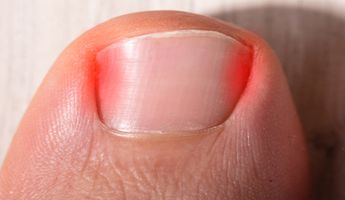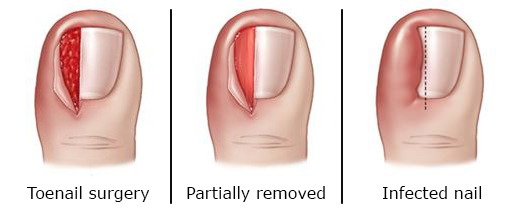Ingrown Toenail Treatment in Iran
Search and Compare the Best Clinics and Doctors at the Lowest Prices for Ingrown Toenail Treatment in Iran

Find the best clinics for Ingrown Toenail Treatment in Iran
No clinics available
Malaysia offers the best prices Worldwide
Price: $ 13

- Home
- Iran
WHY US?
At Medijump, we're making medical easy. You can search, compare, discuss, and book your medical all in one place. We open the door to the best medical providers worldwide, saving you time and energy along the way, and it's all for FREE, no hidden fees, and no price markups guaranteed. So what are you waiting for?

Free

Best Price

Widest Selection

Risk-Free
What you need to know about Ingrown Toenail Treatment in Iran

An ingrown toenail, also known as onychocryptosis, is a condition that occurs when the edge of the nail grows into the skin of the toe. It can result in swelling, pain, and redness. Sometimes, you can take care of ingrown toenails on your own. However, if the pain is spreading or severe, you may need medical treatments. You may also want to promptly seek medical treatments if you have diabetes, a compromised immune system, or poor circulation.
The treatment option for ingrown toenail may include lifting the nail, removing some of the nail (partial nail removal), and removing all of the nail and tissue (total nail removal). The type of treatment you will undergo depends on your specific condition.
What does the Procedure Involve?
Lifting the nail
If your problem is mild, meaning the nail is only slightly ingrown and there is no pus, your doctor may be able to carefully lift the edge of the ingrown nail and place a splint, dental floss, or cotton under it. The splint, dental floss, or cotton will set the nail in a new position, separating the nail from the overlying skin and helping it to grow above the skin.
Partial nail removal
Partial nail removal may be needed for a more severe ingrown toenail. This means that there’s redness, pain, and pus.
During partial nail removal, your doctor will cut away the sides of the nail so that the edges are completely straight. Then, a piece of cotton or a splint is placed under the remaining portion of the nail in order to stop the ingrown toenail from recurring. In some cases, your doctor may also use a compound called phenol to treat your toe. Phenol can keep the nail from growing back.
Total nail removal
If you experience ingrown toenails repeatedly on the same toe or if your ingrown toenail is caused by thickening, your doctor may remove your whole nail along with the underlying tissue (nail bed).
To start the procedure, your doctor will loosen the skin around and from the nail. Then, the nail is separated from the skin by using a special tool under the nail. Your doctor may use a laser, a chemical, or other methods to remove the nail.
All procedures are performed under local anesthesia, which is injected directly into the toe. With local anesthesia, you will be awake but your toe will be numbed, so you will not feel anything throughout the procedure.
How Long Should I Stay in Iran?
You are allowed to leave the hospital on the same day of your ingrown toenail treatment. However, it is recommended that you stay in Iran for a few days following the surgery, at least 3 days, to let your toenail to recover before you travel home. It may be uncomfortable for you to travel long distances during your initial recovery time.
What's the Recovery Time?
Recovery can be different for everyone. On average, it takes about four to six weeks to heal after partial nail removal and around 10 to 12 weeks after total nail removal. During the recovery time, you should be able to walk and carry on your life as normal after 3 days of rest. However, you need to avoid strenuous activities, including running and jumping for 2 weeks. It is also advisable that you avoid taking part in sports activities and dancing until you have fully healed.
What About Aftercare?
Your doctor will give you specific aftercare instructions, which may include:
-
If your doctor gives you pain reliever make sure to take it as directed. Your doctor may also give you oral or topical Medication (antibiotics) which helps get rid of the infection.
-
Keep your foot raised for a day or two to allow your toe to heal properly.
-
Wear special footwear for the first few days. Then, you can slowly start wearing sandals or open-toed shoes until the area feels better.
-
Avoid picking at the wound.
-
Keep the wound clean and dry, except when cleaning the area or showering.
-
Soak your toenails with salt water daily.
What's the Success Rate?
Ingrown toenail treatment is a safe procedure. According to the National Health Services (NHS), partial nail removal is 98% effective in preventing future ingrown toenails. It is important, however, to remember that every type of surgery carries some possible risks, such as toenail deformity, infection, and anesthesia complications. Serious complications are typically rare and untreated ingrown toenails carry a much higher risk of complications.
Are there Alternatives to Ingrown Toenail Treatment?
If your ingrown toenail is not infected, you should be able to treat it with home remedies, such as keeping your feet dry, soaking your feet in warm water, using a wedge to lift your nail and apply antibiotic creams. However, if your ingrown toenail is infected, there’s no alternative than to get the medical treatments mentioned above.
What Should You Expect Before and After the Procedure
Before ingrown toenail treatment, you may experience swelling, tenderness, hardness, redness, bleeding, pain, and pus coming out of your toe. In some cases, the condition can be serious and cause an infection in the bone, leading to foot ulcers and tissue decay at the site. After treatment, all of the painful symptoms you experience before will be relieved and the chance of the condition to complicate will be reduced.
Whilst the information presented here has been accurately sourced and verified by a medical professional for its accuracy, it is still advised to consult with your doctor before pursuing a medical treatment at one of the listed medical providers
No Time?
Tell us what you're looking for and we'll reachout to the top clinics all at once
Enquire Now

Popular Procedures in Iran
Prices Start From $14

Prices Start From $4

Prices Start From $106

Prices Start From $11

Recommended Medical Centers in Iran for procedures similar to Ingrown Toenail Treatment

- Interpreter services
- Translation service
- Religious facilities
- Medical records transfer
- Medical travel insurance
- Health insurance coordination
- TV in the room
- Safe in the room
- Phone in the room
- Private rooms for patients available

- Interpreter services
- Translation service
- Religious facilities
- Medical records transfer
- Medical travel insurance
- Health insurance coordination
- TV in the room
- Safe in the room
- Phone in the room
- Private rooms for patients available

- Interpreter services
- Translation service
- Religious facilities
- Medical records transfer
- Medical travel insurance
- Health insurance coordination
- TV in the room
- Safe in the room
- Phone in the room
- Private rooms for patients available
Ingrown Toenail Treatment in and around Iran
Introduction
Iran is a country situated in Western Asia, as well as the second-largest in the Middle East. It is home to one of the oldest civilizations in the world, starting from the fourth millennium BC when the Elamite Kingdoms were formed. Iran is widely known as the jewel in Islam’s crown, filled with awe-inspiring architecture and friendly people. The country is also a popular medical tourism destination due to its efficient healthcare system and experienced specialists. The medical centers in the country keep pace with the latest medical developments and provide top-class services. International medical tourists usually come to Iran for cosmetic procedures, which are currently witnessing a vast growth. Cosmetic procedures in the country, such as rhinoplasty and hair transplant, are performed with advanced scientific techniques and are highly successful. Furthermore, the healthcare cost in the country is a lot more affordable than in many other Western countries.
Popular Cities and Regions in Iran
The capital of Iran, Tehran, is the most populous city in the country. Situated at the foot of the snow-capped Alborz mountain range, the city is filled with museums, restaurants, parks, and friendly people. The most popular landmark in this city is the Azadi Tower, which is the symbol of the city. Besides this tower, visitors can also go to the Tehran City Theater to see its amazing architecture, explore the Treasury of the National Jewels to admire the largest collection of jewels found in the world and visit the Golestan Palace, which is the oldest historic monument in Tehran. Besides Tehran, Tabriz is another popular city and it is a modern industrialized city with a very rich history and historical monuments, such as the Blue Mosque and El Goli.
Transport in Iran
The main international airport is the new Imam Khomeini International Airport in Tehran. It serves international flights to and from numerous cities around the world, including Dubai, Ankara, London, Bangkok, and Beijing. Budget airlines are operating from this airport, such as Pegasus Airlines and Air Asia. To get around Iran, domestic flights are affordable and fast. Buses and trains are also widely available with extensive networks. Taxis are best for inter-city travel.
Visas in Iran
Iran allows citizens of 16 countries to visit without a visa for up to 90 days, including Armenia, China, and Malaysia. Most citizens of other countries can obtain a visa on arrival. However, visa on arrival does not apply to citizens of 14 other countries, such as the US and the UK.
Weather in Iran
Iran experiences four seasons. Spring (March-May) and autumn (September –October) are pleasant with mild temperatures. Summer (June to August) can be scorching hot, with the temperatures soaring to 37°C. The winter can get bitterly cold as the temperatures drop to 0°C.
Additional Info
- Local Currency: The official currency is the Iranian rial (IR). 1 USD is approx. 41,921 IR.
- Money & Payments: You cannot use ATMs, credit or debit cards, or traveler's cheques in Iran. Therefore, bring all you’ll need in cash.
- Local Language: Persian is the official language in Iran. However, the country has several main languages, including Azerbaijani and Kurdish. Not many people speak English in the country.
- Local Culture and Religion: About 99% of Iran’s population is Muslims, with the Shia branch of Islam as the biggest. The two largest non-Muslim religious minorities are Christianity and Bahá'í Faith.
- Public holidays: Islamic Revolution Day, Nature Day, Eid e-Fitr, and Eid-e-Qorban are some of the most important public holidays in Iran.
Popular Searches
- Plastic Surgery in Thailand
- Dental Implants in Thailand
- Hair Transplant in Thailand
- Breast Augmentation Thailand
- Gastric Sleeve in Thailand
- Gender Reassignment Surgery in Thailand
- Laser Hair Removal in Bangkok
- Botox in Bangkok
- Dermatology in Bangkok
- Breast Augmentation in Bangkok
- Coolsculpting in Bangkok
- Veneers in Turkey
- Hair Transplant in Turkey
- Rhinoplasty in Turkey
- Stem Cell Therapy in Mexico
- Rhinoplasty in Mexico
- Liposuction in Mexico
- Coolsculpting in Tijuana
- Rhinoplasty in Korea
- Scar Removal in Korea
- Gastric Sleeve in Turkey
- Bone Marrow Transplant in India
- Invisalign in Malaysia
- Plastic Surgery in the Dominican Republic
- Tummy Tuck in the Dominican Republic
- Plastic and Cosmetic Surgery in Poland
- Rhinoplasty in Poland
- Hair Implant in Poland
- Dental Implants in Poland
- IVF in Turkey